
HOME
INTRO
SYMBOLS
ALMANAC
ECONOMY
GEOGRAPHY
STATE MAPS
PEOPLE
FORUM
NEWS
COOL SCHOOLS
STATE QUIZ
STATE LINKS
BOOK STORE
MARKETPLACE
GUESTBOOK
CONTACT US


You may double left-click on a word on this page to retrieve its definition. Tweet Follow
Nebraska State American Folk Dance
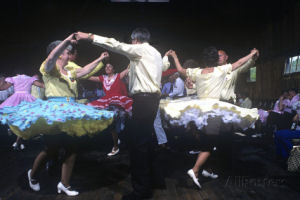
Nebraska State American Folk Dance: Square Dance
Photographs, posters and prints
Contrary to the practices of other states, the governor of Nebraska has been empowered to designate official state "items." In 1997, the Nebraska Unicameral Legislature granted the governor this authority by an act of law.
This action was taken to allow lawmakers to excuse themselves entirely from this kind of legislative activity, thus avoiding any criticism that invariably came from some Nebraska citizens.
Section 90-119 of the Nebraska Statutes reads:
90-119.
Governor; designate official state items.
The Governor may designate official state items, including animals, plants, minerals, and other things. Legislative approval of any such designation is not required. Any designation made on or prior to September 13, 1997, is not affected by this section.
Source
Laws 1997, LB 106, § 1.
In line with this act of the legislature, the square dance was declared the "official state American folk dance" by Governor Ben Nelson on September 19, 1997.
The Nebraska Blue Book has this to say about Nebraska's American folk dance:
"On Sept. 19, 1997, Gov. Ben Nelson declared the square dance to be the official state American folk dance. Square dancing developed as the nation progressed toward the west. It became a popular diversion from the hardships settlers faced. Square dancing is called, cued or prompted to dancers. Related forms include round dancing, clogging, contra dancing and line dancing."
(Nebraska Blue Book, 2014-15, p. 16)
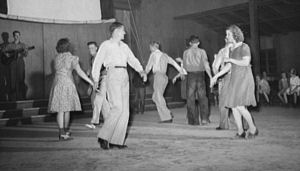
Saturday Night Square Dancing (1942)
In addition to the official American folk dance, Governor Nelson also named a number of other official "items" in 1997. He designated an official state ballad and an official state fish. The city of Colby was declared the "Village of Lights" and the cities of Wakefield and St. Paul were named the "baseball capital" and "historic baseball capital" respectively.
In the early 1990s, Al and Donna Moffit looked to be tasked with the project to get the square dance designated the American folk dance of the State of Nebraska.
With the change in process declared by the legislature, it is not clear how the designation came about. In the end Donna Bolz received credit for the accomplishment.
Thanks to the efforts of LEGACY Trustee Donna Bolz, the elusive thirtieth state has been reached for this ongoing project of LEGACY & USDA.
("American Squaredance", 1998, p. 84)
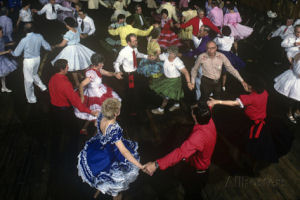
Nebraska State American Folk Dance: Square Dance
Photographs, posters and prints
The United Square Dancers Association, Inc. (USDA) has declared that Nebraska was the thirtieth state to officially adopt the square dance as an official American folk dance. Though it hardly matters, we question this assertion.
If you haven't read it, a brief article about the campaign to declare the square dance the national folk dance of the United States of America can be found here.
The square dance is a popular type of folk dance in the United States. This dance for four couples, or groups of four couples, is performed in a compact framework of a square, each couple forming a side. Traditionally accompanied by a fiddle, accordion, banjo and guitar, the couples perform a variety of movements prompted by the patter or singing calls (instruction) of a "caller". Cooperative movement is the hallmark of well-executed square dancing.
Square dancing is to be distinguished from related dances called contra or longways dance where couples stand double file in a line and from round dances where couples stand in a circle. The origin of the square dance can be traced to English derivation and to the stately French cotillion performed in square formation that was popular at the court of Louis the fifteenth later replace by the quadrille (another square dance).
Nebraska Law
Declarations by the governor are not considered acts of law. They do not require approval of the legislature and are not recorded in the Nebraska Revised Statutes.
Sources...
Nebraska Blue Book. 52nd. ed. Lincoln: Nebraska Unicameral Legislature. 2014-15. Nebraska Unicameral Legislature. State of Nebraska. Web. 15 Mar. 2016.
"Nebraska the 30th State." American Squaredance Feb. 1998: 84. Print.
"Section 90-119." Nebraska Revised Statutes. Nebraska Unicameral Legislature. Web. 24 Feb. 2005.
Shearer, Benjamin F. and Barbara S. State Names, Seals, Flags and Symbols: A Historical Guide Third Edition, Revised and Expanded. Westport, Conn: Greenwood Press, 3 Sub edition, 2001.
"Thirteenth State Folk Dance." American Squaredance May 1991: 62. Print.
Additional Information
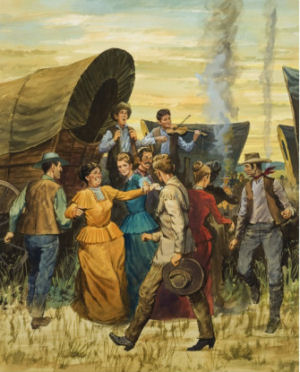
Nebraska State American Folk Dance: Square Dance
Photographs, posters and prints
Square Dancing 101: Square dancing basic including positions, formations, moves, and a glossary.
Video Square Dance Lessons Online: Video Square Dance Lessons Online and on DVD from Cyberpoint Marketing, LLC.
A Brief History of Square and Round Dancing: by Herb Egender.
Square Dancing: The Historical Geography of an American Folk Custom: by Richard M. MacKinnon, Allan Hancock College, Santa Maria, California.
Square Dance History Project: Website devoted to the documenting the history of square dancing with historical documents and an emphasis on imagery as much as possible.
History and Heritage of Modern American Square Dancing: A summary of the essays by Dorothy Shaw, Bob Osgood and Kenny Reese.
The State Folk Dance Conspiracy: Fabricating a National Folk Dance: by Judy Mangin - Originally published in the Old-Time Herald, v.4(7) p.9-12, Spring 1995.
National Folk Dance Effort Moves Forward: We're On Our Way Now, So Let's Make a Lot of Noise!: United Square Dancers of America National Folk Dance Committee.
The Square Dance Legislation Collection: American Folklife Center 1984/024, Compiled by Michelle Forner, Library of Congress, Washington DC, December 1994
Official website: Nebraska State Square and Round Dance Association, Inc.
State dances: Complete list of official state dances from NETSTATE.COM
More symbols & emblems: Complete list of official Nebraska state symbols from NETSTATE.COM.
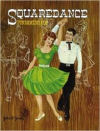
Square Dance Fundamentals
John W. Jones
Square Dance Fundamentals, John W. Jones. 208 pages. Publisher: BookSurge Publishing (February 5, 2007)
While there have been countless fun books written on square dancing, Squaredance Fundamentals was the first to cut to the chase. There is no interesting history of square dancing, there are no entertaining anecdotes, just the nuts and bolts of how to square dance. Revolutionary illustrations show the dancer’s point of view, not just the spectators’ viewpoint. Dancers can, without turning on their heads, glean from the detailed illustrations exactly what they need to be doing with their hands, feet, etc. Each dancer can effortlessly grasp the material and easily retain it. Renowned master caller/teacher, Marshall Flippo, assiduously assisted the author in establishing the very first guidelines for standardized “Basic Maneuvers” which would enable square dancers to dance gracefully with any group, anywhere.
No one shows you better how to execute the maneuvers than John W. Jones with his super simplified instructions and state-of-the-art illustrations in Squaredance Fundamentals - the gold standard for over 37 years.
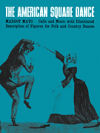
The American
Square Dance
Margot Mayo
The American Square Dance, by Margot Mayo. 116 pages. Publisher:Music Sales American (September 1, 2006)
You can have fun square dancing and you'll learn how to dance the figures and even learn how to call a square dance with Margot Mayo's classic manual, The American Square Dance. Here is the basic book for square dancers containing all of the essentials for many hours of enjoyment. An illustrated glossary of square dance terms shows all of the basic square dance figures – promenade, allemande left, do-si-do, etc. Complete instructions, calls and illustrated figures for 13 of the most popular American square dances appear, plus the music all ready for your pianist and fiddlers to play.
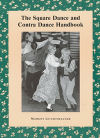
The Square Dance and
Contra Dance Handbook
Margot Gunzenhauser
The Square Dance and Contra Dance Handbook: Calls, Dance Movements, Music, Glossary, Bibliography, Discography, and Directories, by Margot Gunzenhauser. 320 pages. Publisher: McFarland & Company, Inc., Publishers; annotated edition (July 28, 2010)
This comprehensive guide to traditional style square and contra dancing, sometimes referred to as "country dancing," covers both music and style and gives background information on various dance types and calling techniques. Ninety dances, presented in chapters according to type (mixers, progressive circles, contra, Southern mountain style, squares and others), in a wide variety of formations are described with drawings and diagrams for many of the movements. A glossary of terms, a directory of addresses (organizations; vendors of books, recordings and audio equipment; and dance camps), and an annotated discography and bibliography are also provided.
A glossary of terms, a directory of addresses (organizations; vendors of books, recordings and audio equipment; and dance camps), and an annotated discography and bibliography are also provided.
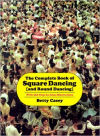
The Complete Book
of Square Dancing
(and Round Dancing)
Betty Casey
The Complete Book of Square Dancing (and Round Dancing), by Betty Casey. 208 pages. Publisher: University of North Texas Press (June 1, 2000)
This book includes: 50 basic movements, 35 advanced movements, variations, dances that are a part of the American heritage, Contra and Round Dances, polkas and reels, and calls, past and present.
“Square dancing is friendship set to music,” says author Betty Casey. Just take four couples, old or young, put ’em on a good floor, turn on the music, and you’re all set. Whether you’ve done it before or you’re just starting out, this book tells you everything you need to know—85 basic movements used all over the world, the spirited calls unique to square dancing, the costumes and equipment that are best, and music (from “Red River Valley” to “Mack the Knife”) that will set your feet in motion.
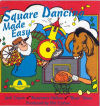
Square Dancing
Made Easy
Square Dancing Made Easy, Grade level: K-6. Audio CD (September 1, 1995), Number of Discs: 1, Label: Educational Activities, Inc.
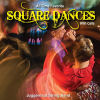
All Time Favorite
Square Dances
All Time Favorite Square Dances with Calls, Audio CD (September 8, 2009), Number of Discs: 1, Label: KADO, Run Time: 60 minutes.
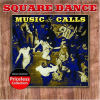
Square Dance Music
& Calls
Square Dance Music & Calls, Audio CD (November 21, 2006), Number of Discs: 1, Label: Collectables Records.
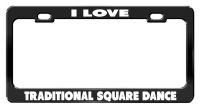
Black Metal
License Plate Frame
I LOVE TRADITIONAL SQUARE DANCE Black Metal Car Accessories License Plate Frame, This high quality license plate frame is made of metal, and it's the best quality item of its kind in the market. The lettering and art work are done by waterproof vinyl on the license plate frame and it will last for many years without any damage. It will not get brittle or cracked. It fits on all USA and Canada vehicles. It measures 12.5" X 6.5" and is durable to last under all weather conditions.
- Heavy Duty High Quality Metal License Plate Frame.
- Perfect Gift idea And Easy Installation.
- Rust, Corrode And Fade Free For Many Years.
- Fits all US and Canada License Plates.
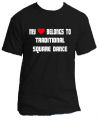
Traditional Square
Dance T-Shirt
MY HEART BELONGS TO TRADITIONAL SQUARE DANCE, This is a high quality pre-shrunk t-shirt that will not shrink or fade. It's comfortable, casual and loose fitting and will quickly become one of your favorites. It wears and looks well on anyone. It is cured with a heat treatment process to ensure lasting durability.
Brand New High quality preshrunk tee-shirt that will not shrink or fade. Double-needle stitched hemmed sleeves and bottom. Highest quality printing materials. 50% Cotton, 50% Polyester preshrunk blend. Soft, comfortable and weighs 6 oz.
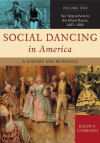
Social Dancing in America: A History and Reference (Volume One), by Ralph G. Giordano. 380 pages. Publisher: Greenwood (November 30, 2006)
Social Dancing in America examines the role of social dancing in daily life from the first settlements in 1607 through the birth of the nation in 1776 and into the beginning of the 21st century. This two-volume set provides a history of American social dances including the Virginia Reel, Square Dancing, the Lindy Hop, Rock 'n' Roll, the Twist, Disco, Breakdancing, and Hip-Hop. Social Dancing in America places social dancing in a historical, social, cultural, and political context.
Volume 1 explores the integral role that social dancing played in the lives of Americans from the first settlements in 1607 through the 19th century, often in the most unlikely of ways. For example, readers may be surprised to learn that George Washington was a well-known aficionado of social dancing, and that he incorporated the etiquette and manners of dances such as the Minuet as a means of diplomacy to secure European allies during the Revolutionary War. After his death, Americans continued to celebrate his birthday with a grand ball that included dancing.
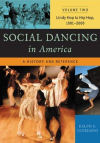
Social Dancing in America: A History and Reference (Volume Two), by Ralph G. Giordano. 428 pages. Publisher: Greenwood (November 30, 2006)
Volume 2 places social dance in a 20th-Century context, illustrating how social dancing itself paralled the social, economic, and cultural traditions of each era. For example, segregation and the Jim Crow mentality was cemented in place all over the United States, and for much of the century, dancing and dance halls were strictly segregated. Segregation forced a mass migration north, and with it came the transformation of Delta Blues music into an American original—Jazz. Jazz gave birth to the Charleston, and later evolved into Swing, which created the Lindy Hop. Later, with the advent of television, programming such as American Bandstand, Soul Train, Dance Fever, and MTV greatly influenced dance styles and modern trends such as Rock 'n' Roll, Freestyle, Disco, Breakdancing, and Hip-Hop.

